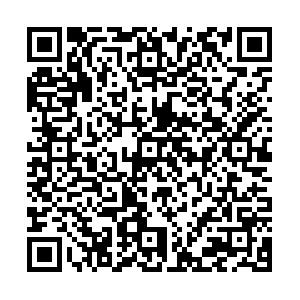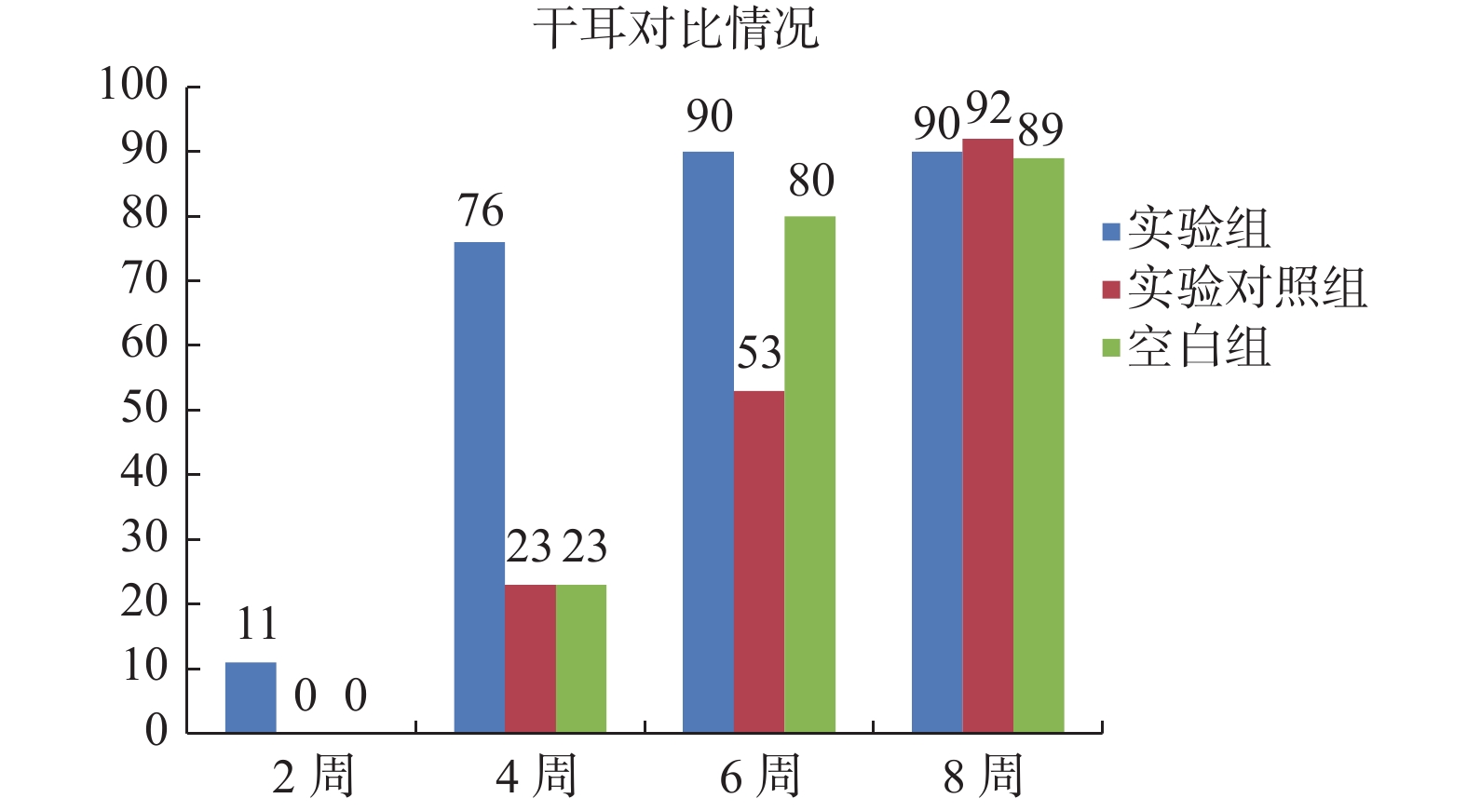Clinical Application of Xenogenic Acellular (bovine) Dermal Matrix with Autologous Bone Powder Implantation in Open Mastoidectomy
-
摘要:
目的 旨在分析研究异种(牛)脱细胞真皮基质联合自体骨粉植入应用于开放式乳突根治术中,对患者术后快速干耳、上皮化、自体骨粉成活及降低术后感染机率的影响。 方法 收集自2016年9月至 2020年9月间在昆明医科大学第一附属医院耳鼻喉Ⅰ科就诊并行手术治疗的中耳炎患者,将其根据本研究实验要求分为以下3组:(1)中耳炎患者中行开放式乳突根治术+异种(牛)脱细胞真皮基质联合自体骨粉植入的患者(实验组);(2)中耳炎行开放式乳突根治术+筋膜联合自体骨粉植入的患者(实验对照组);(3)中耳炎行开放式乳突根治术+筋膜置入(空白对照组);分别于术后2周、4周、6周、8周详细记录3组患者:(1)干耳;(2)上皮化;(3)骨粉是否成活;(4)是否感染4个方面。 结果 对术后2周、4周、6周3组间干耳发生率及术后4周、6周3组间上皮化发生率进行比较,术后2周、4周、6周实验组干耳发生率及术后4周、6周实验组上皮化发生率高于空白对照组与实验组对照组(P < 0.05);而空白对照组与实验对照组比较无差异;3组间术后2周、4周、6周感染率比较差异无统计学意义(P > 0.05)。对术后8周3组间干耳发生率、上皮化发生率、感染率进行比较,结果均为P > 0.05,差异无统计学意义。 结论 异种(牛)脱细胞真皮基质联合自体骨粉植入应用于开放式乳突根治术中,术后能显著快速有效地缩短干耳时间,快速上皮化,于术后4~6周内能达到干耳、上皮化,确切保证植入的自体骨粉成活,从而有效降低了术后感染机率,最终提高远期疗效。 -
关键词:
- 异种(牛)脱细胞真皮基质 /
- 干耳 /
- 上皮化 /
- 自体骨粉 /
- 感染
Abstract:Objective To investigate the application of xenogenic acellular (bovine) dermal matrix (ADM) combined with autologous bone powder implantation in open mastoidectomy, and investigate the effect on ear drying, epithelization, survival of autogenous bone meal and reduction of postoperative infection rate. Methods From September 2016 to September 2020, patients with otitis media who were treated by surgery in department I of Otolaryngology, First Affiliated Hospital of Kunming Medical University were divided into three groups according to the requirements of this study: (1) Patients with otitis media who underwent open radical mastoidectomy + xenogeneic (bovine) acellular dermal matrix combined with autologous bone meal implantation (experimental group); (2) Patients with otitis media underwent open radical mastoidectomy and fascia combined with autologous bone meal implantation (experimental control group); (3) Otitis media were treated with open radical mastoidectomy and fascia implantation (blank control group); At 2 weeks, 4 weeks, 6 weeks and 8 weeks after operation, the following four aspects were recorded: (1) dry ear; (2) epithelization; (3) survival of bone powder; (4) infection Results. After 2 weeks, 4 weeks, 6 weeks, the incidence of dry ear and the incidence of epithelization between 4 weeks, 6 weeks after operation were compared. The chi square test showed that the results were P < 0.001, which was statistically significant. The test level was adjusted and compared. Results The blank control group, the experimental control group and the experimental group were all P < 0.001. The incidence of dry ear and epithelialization in the experimental group was higher than that in the blank control group and the experimental control group at 6 weeks and 4 and 6 weeks after operation, but there was no difference between the blank control group and the experimental control group; There was no significant difference in the infection rate among the three groups at 2, 4 and 6 weeks after operation (P > 0.05). The incidence of dry ear, epithelization and infection were compared between the two groups on the 8th week after operation, and the results were all P > 0.05, without statistical significance. Conclusions Xenogenic acellular (bovine) dermal matrix (ADM) combined with autologous bone powder implantation in open radical mastoidectomy can significantly shorten the dry ear time and epithelialize quickly after operation. It can achieve dry ear and epithelialization within 4 to 6 weeks after operation, and ensure the survival of autologous bone powder implantation, thus effectively reducing the incidence of infection after operation, improving long-term efficacy. -
表 1 3组间年龄的比较[(
$\bar x \pm s $ ),岁]Table 1. Comparison of age between three groups [(
$\bar x \pm s $ ),岁]组别 n 年龄 F P 空白对照组 93 42.87 ± 9.88 0.80 0.451 实验组 90 41.48 ± 10.10 实验对照组 94 43.27 ± 10.16 表 2 3组间性别分布比较(n)
Table 2. Comparison of gender distribution between the three groups (n)
组别 男 女 χ2 P 空白对照组 46 47 0.36 0.837 实验组 43 47 实验对照组 49 45 表 3 术后2周3组间临床观察项目比较[n(%)]
Table 3. Comparison of clinical observation items between 3 groups after operation [n(%)]
观察项目 空白对照组(n = 93) 实验组(n = 90) 实验对照组(n = 94) χ2 P 干耳 0(0.0) 11(12.2) 0(0.0) 23.80 < 0.001 上皮化 0(0.0) 0(0.0) 0(0.0) - - 感染 0(0.0) 0(0.0) 0(0.0) - - 表 4 术后4周3组间临床观察项目比较[n(%)]
Table 4. Comparison of clinical observation items between 3 groups 4 weeks after operation [n(%)]
观察项目 空白对照组(n = 93) 实验组(n = 90) 实验对照组(n = 94) χ2 P 干耳 23(24.7) 76(84.4) 23(24.5) 88.30 < 0.001 上皮化 0(0.0) 76(0.0) 0(0.0) 217.62 < 0.001 感染 3(3.2) 0(0.0) 2(2.1) 4.19 0.123 表 5 术后6周3组间临床观察项目比较[n(%)]
Table 5. Comparison of clinical observation items between 3 groups 6 weeks after operation [n(%)]
观察项目 空白对照组(n = 93) 实验组(n = 90) 实验对照组(n = 94) χ2 P 干耳 80(86.0) 90(100.0) 79(84.0) 15.19 0.001 上皮化 80(86.0) 90(100.0) 79(84.0) 15.19 0.001 感染 4(4.3) 0(0.0) 2(2.1) 5.50 0.064 表 6 术后8周3组间临床观察项目比较[n(%)]
Table 6. Comparison of clinical observation items between 3 groups 8 weeks after operation [n(%)]
观察
项目空白对照组
(n = 93)实验组
(n = 90)实验对照组
(n = 94)χ2 P 干耳 89(95.7) 90(100.0) 91(96.8) 5.75 0.056 上皮化 89(95.7) 90(100.0) 91(96.8) 5.75 0.056 感染 4(4.3) 0(0.0) 2(2.1) 5.50 0.064 表 7 2组间自体骨粉成活结果比较[n(%)]
Table 7. Comparison of survival results of autogenous bone meal between the two groups [n(%)]
组别 术后2周 术后4周 术后6周 术后8周 实验组 0(0.0) 76(84.4) 90(100.0) 90(100.0) 实验对照组 0(0.0) 0(0.0) 79(84.0) 91(97.9) P - < 0.001 < 0.001 0.246 -
[1] 孙建军,刘阳. 中耳炎临床分类和手术分型指南(2012)解读[J]. 中华耳鼻喉头颈外科杂志,2013,48(1):1-5. [2] Bassiouny M,Badour N,Omrana,et al. Histopathological and immunohistochemical characteristics of acquired cholesteatoma in children and adults[J]. Egypt J Ear Nose Throat Allied Sci,2012,13(3):7-9. doi: 10.1016/j.ejenta.2012.02.007 [3] Klenke C,Janowski S,Borck D,et al. Identification of novel cholesteatoma-raleted gene expression signatures using full-genome microarrays[J]. PLoS One,2012,7(2):15-18. [4] Maniu A,Harabagiu O,Pered M,et al. Molecular biology of cholesteatoma[J]. Rom J Morphol Embryol,2014,55(4):7-10. [5] Dornelles Cde C,da Costa S S,Meurer L,et al. Comparisonof acquired chlesteatomabetween pediatric and adult patiens[J]. EurArch Otorhinolaryngol,2009,266(3):1553-1556. doi: 10.1007/s00405-009-0957-0 [6] LANGEVINSM,Christensen B C. Let-7microRNA-binding-site ploymorthism in the 3’UTR of KRAS and colorectal cancer outcome:a systematic review and eat-analysis[J]. Cancer Med,2014,3(1):1385-1389. doi: 10.1002/cam4.279 [7] Zhang W,Chen X,Qin Z. Micro RNAlet-7asuppresses the growth and invasion fo cholesteatoma keratinocytes[J]. Mol Med Rep,2015,11(3):2097-2099. doi: 10.3892/mmr.2014.2971 [8] Nguyen K H,Suzuki H,Ohbuchi T,et al. Possible participation of acidic pH in bone resorption in middle ear cholesteatoma[J]. Laryngoscope,2014,124(4):245-259. doi: 10.1002/lary.23883 [9] Louw L. Acquired cholesteatoma:summary of the cascade of molecular evens[J]. laryngol Otol,2013,127(1):542-546. doi: 10.1017/S0022215113000601 [10] Yoshikawa M,Kojima H,et al. Cholesteatoma fibrolasts promote epithelial cell proliferation through overexpression of epiregulin[J]. PLoS One,2013,8(2):719-725. [11] Preciado D A. Biology of cholesteatoma:specilconsiderationgs in pediatric patients[J]. Int J Pediatr Otorhinolaryngol,2012,6(3):319-324. [12] Peek Fa,Huisman M A,Berckmans R J,et al. Lipopolysaccharide concentration and bone resorption in cholesteatoma[J]. Otol Neurotol,2003,24(4):709-713. doi: 10.1097/00129492-200309000-00002 [13] Muller P A,Vousdenk H,Norman J C. P53 and its mutants in tumor cell migration and invasion[J]. J Cell Biol,2011,192(3):209-214. doi: 10.1083/jcb.201009059 [14] Huismn M A,Heer E D,Grote J J. Cholesteatoma epithelium is characterized by increased expression Ki-67,P53 and P21,with minimal apoptosis[J]. Acta Otolaryngol,2003,123(1):377-379. doi: 10.1080/00016480310001376 [15] 周永清,李晓明,屈永清,等. 自体骨粉如PALVA瓣堵塞开放式乳突根治术21例近期疗效观察[J]. 临床耳鼻喉头颈外科杂志,2008,22(3):1019-1022. [16] 陈文文,邓亚新,童军,等. 带骨膜骨片重建乳突根治后缺损的耳道壁效果分析[J]. 中华耳科学杂志,2009,7(4):107-111. -






 下载:
下载:






